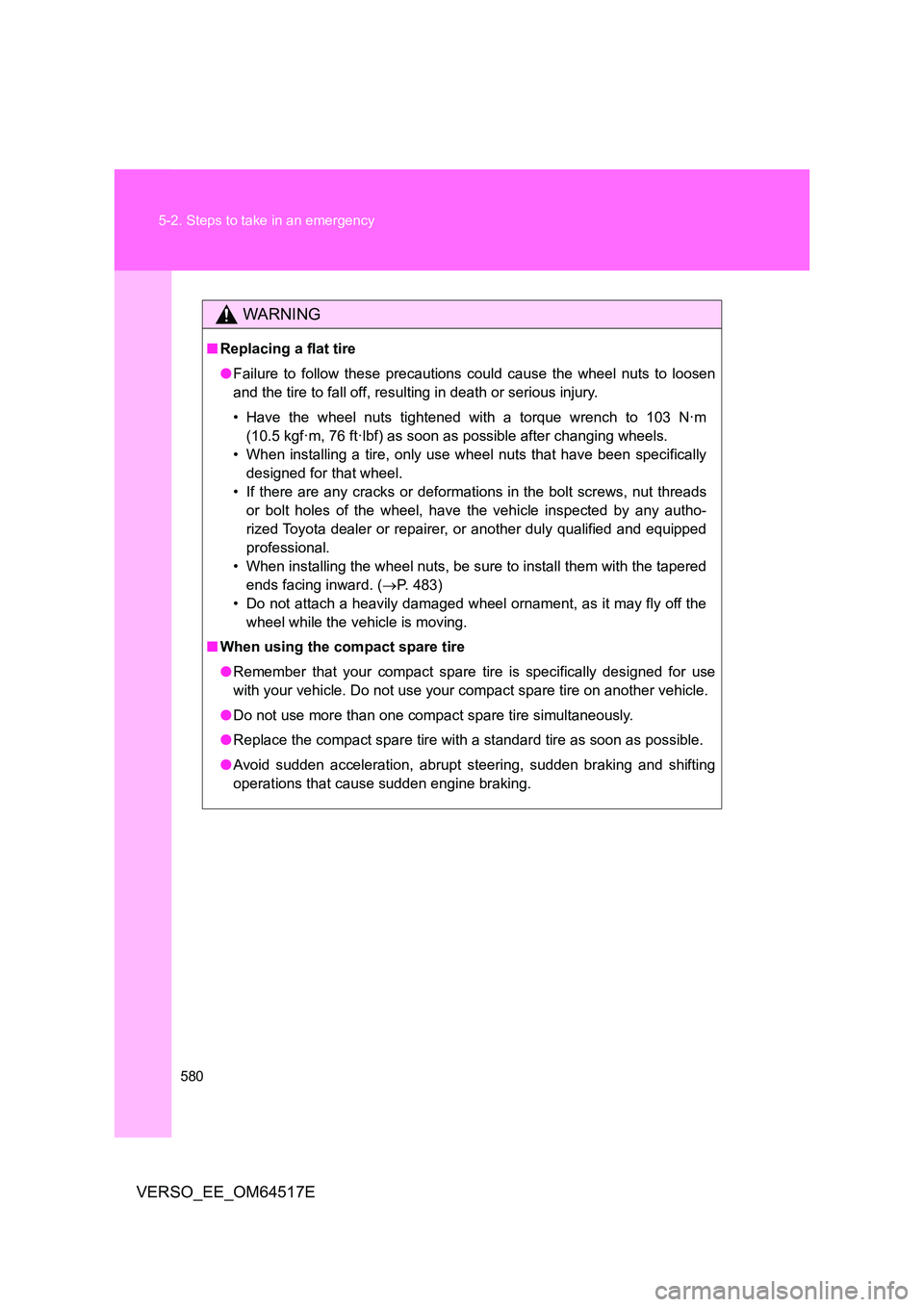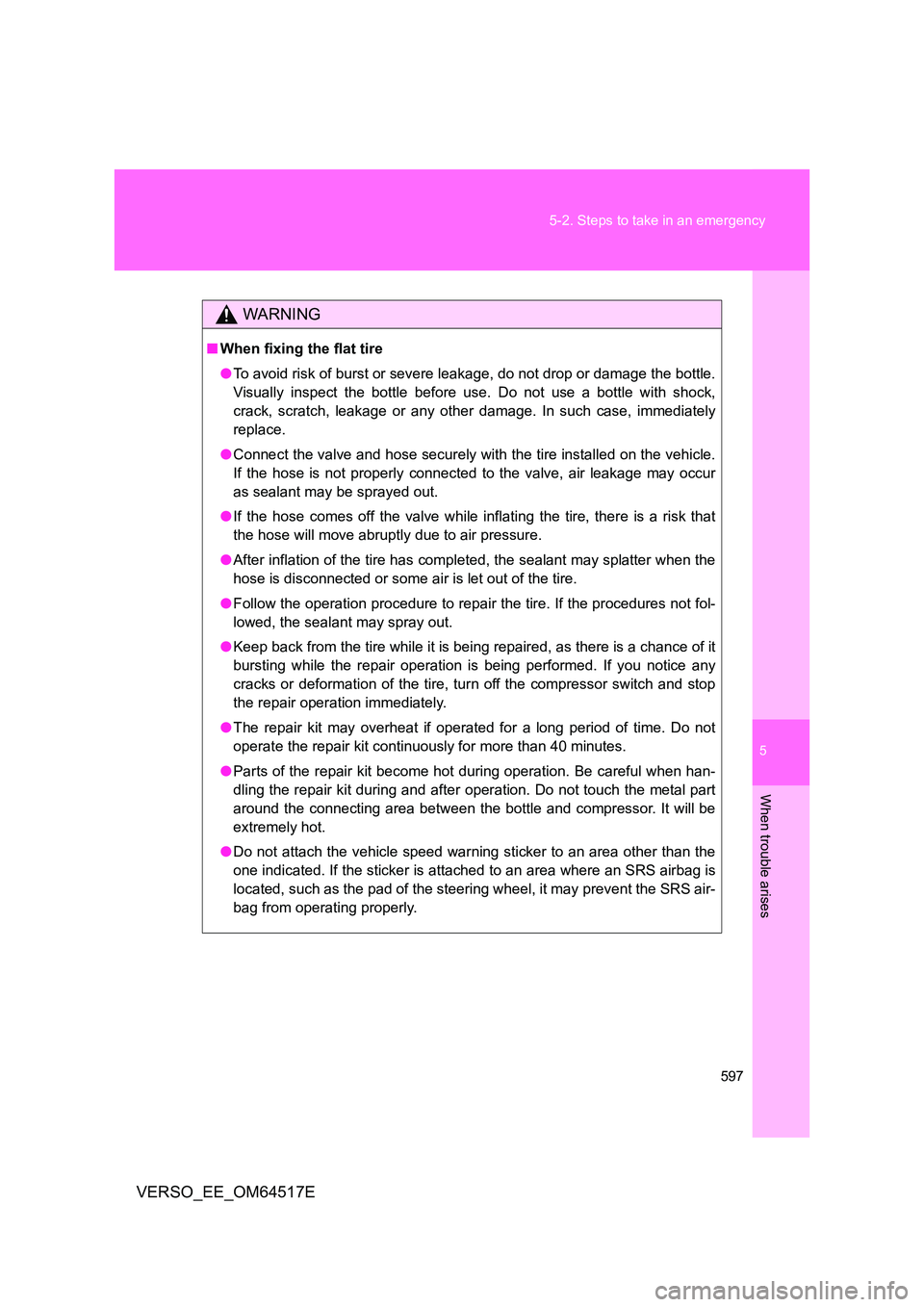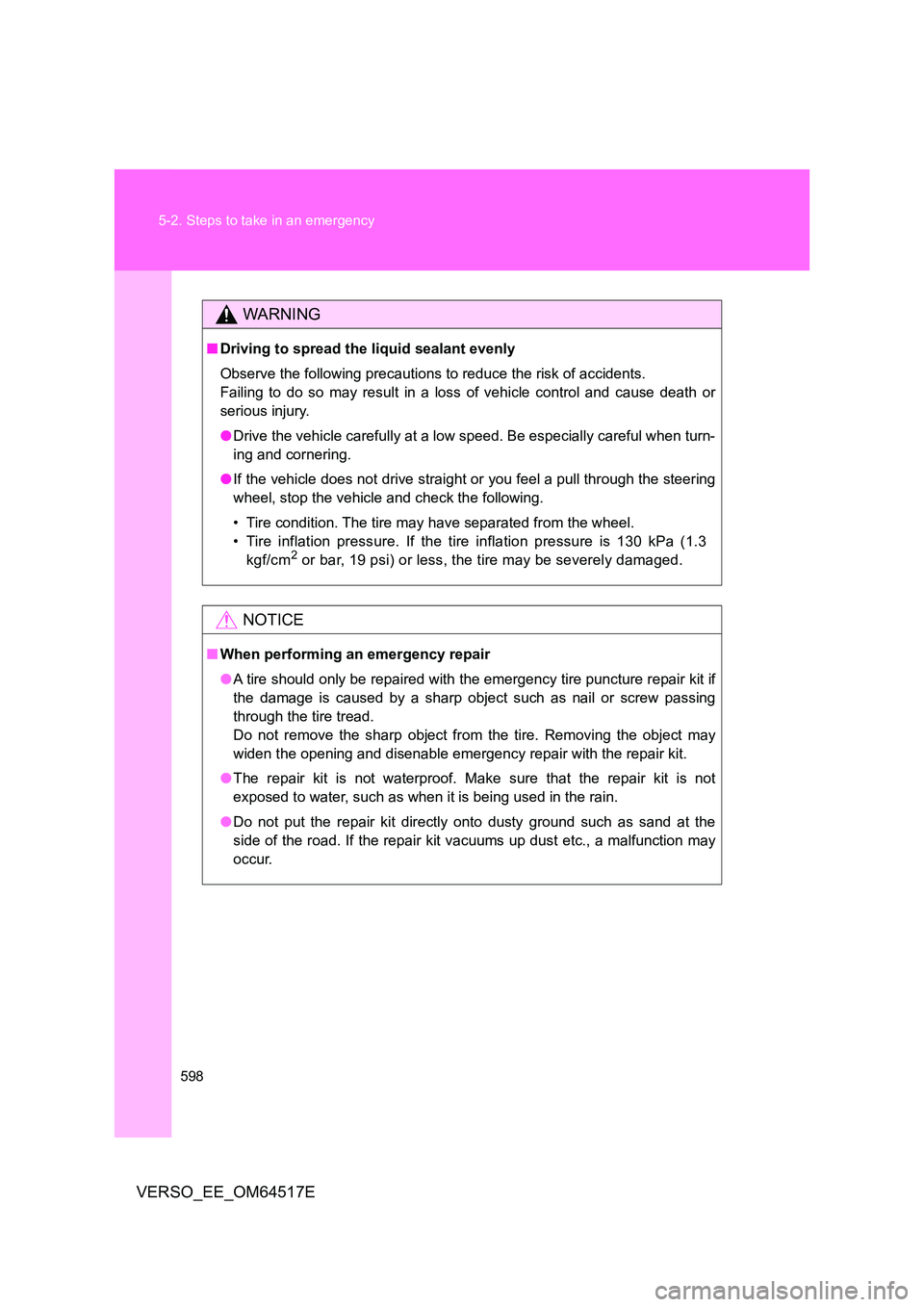Page 565 of 668
5
565
5-2. Steps to take in an emergency
When trouble arises
VERSO_EE_OM64517E
*1: Vehicles with a Multidrive
*2: Vehicles with a manual transmission
Once (Flashes)
(Green
indicator
flashes)
Indicates that
the steering
lock has not
released within
3 seconds of
pressing the
“ENGINE
START STOP”
switch.
Press the
“ENGINE
START STOP”
switch again
while turning
the steering
wheel with the
brake pedal
depressed.
Interior
buzzer
Exterior
buzzerWarning messageDetailsCorrection
procedure
Page 580 of 668

580
5-2. Steps to take in an emergency
VERSO_EE_OM64517E
WARNING
■ Replacing a flat tire
● Failure to follow these precautions could cause the wheel nuts to loosen
and the tire to fall off, resulting in death or serious injury.
• Have the wheel nuts tightened with a torque wrench to 103 N·m
(10.5 kgf·m, 76 ft·lbf) as soon as possible after changing wheels.
• When installing a tire, only use wheel nuts that have been specifically
designed for that wheel.
• If there are any cracks or deformations in the bolt screws, nut threads
or bolt holes of the wheel, have the vehicle inspected by any autho-
rized Toyota dealer or repairer, or another duly qualified and equipped
professional.
• When installing the wheel nuts, be sure to install them with the tapered
ends facing inward. ( P. 483)
• Do not attach a heavily damaged wheel ornament, as it may fly off the
wheel while the vehicle is moving.
■ When using the compact spare tire
● Remember that your compact spare tire is specifically designed for use
with your vehicle. Do not use your compact spare tire on another vehicle.
● Do not use more than one compact spare tire simultaneously.
● Replace the compact spare tire with a standard tire as soon as possible.
● Avoid sudden acceleration, abrupt steering, sudden braking and shifting
operations that cause sudden engine braking.
Page 597 of 668

5
597
5-2. Steps to take in an emergency
When trouble arises
VERSO_EE_OM64517E
WARNING
■ When fixing the flat tire
● To avoid risk of burst or severe leakage, do not drop or damage the bottle.
Visually inspect the bottle before use. Do not use a bottle with shock,
crack, scratch, leakage or any other damage. In such case, immediately
replace.
● Connect the valve and hose securely with the tire installed on the vehicle.
If the hose is not properly connected to the valve, air leakage may occur
as sealant may be sprayed out.
● If the hose comes off the valve while inflating the tire, there is a risk that
the hose will move abruptly due to air pressure.
● After inflation of the tire has completed, the sealant may splatter when the
hose is disconnected or some air is let out of the tire.
● Follow the operation procedure to repair the tire. If the procedures not fol-
lowed, the sealant may spray out.
● Keep back from the tire while it is being repaired, as there is a chance of it
bursting while the repair operation is being performed. If you notice any
cracks or deformation of the tire, turn off the compressor switch and stop
the repair operation immediately.
● The repair kit may overheat if operated for a long period of time. Do not
operate the repair kit continuously for more than 40 minutes.
● Parts of the repair kit become hot during operation. Be careful when han-
dling the repair kit during and after operation. Do not touch the metal part
around the connecting area between the bottle and compressor. It will be
extremely hot.
● Do not attach the vehicle speed warning sticker to an area other than the
one indicated. If the sticker is attached to an area where an SRS airbag is
located, such as the pad of the steering wheel, it may prevent the SRS air-
bag from operating properly.
Page 598 of 668

598
5-2. Steps to take in an emergency
VERSO_EE_OM64517E
WARNING
■ Driving to spread the liquid sealant evenly
Observe the following precautions to reduce the risk of accidents.
Failing to do so may result in a loss of vehicle control and cause death or
serious injury.
● Drive the vehicle carefully at a low speed. Be especially careful when turn-
ing and cornering.
● If the vehicle does not drive straight or you feel a pull through the steering
wheel, stop the vehicle and check the following.
• Tire condition. The tire may have separated from the wheel.
• Tire inflation pressure. If the tire inflation pressure is 130 kPa (1.3
kgf/cm2 or bar, 19 psi) or less, the tire may be severely damaged.
NOTICE
■ When performing an emergency repair
● A tire should only be repaired with the emergency tire puncture repair kit if
the damage is caused by a sharp object such as nail or screw passing
through the tire tread.
Do not remove the sharp object from the tire. Removing the object may
widen the opening and disenable emergenc y repair with the repair kit.
● The repair kit is not waterproof. Make sure that the repair kit is not
exposed to water, such as when it is being used in the rain.
● Do not put the repair kit directly onto dusty ground such as sand at the
side of the road. If the repair kit vacuums up dust etc., a malfunction may
occur.
Page 600 of 668
600
5-2. Steps to take in an emergency
VERSO_EE_OM64517E
If the engine will not start
If the engine still does not start after following the correct
starting procedure ( P. 198, 202) or releasing the steering lock
( P. 200, 205), confirm the following points.
■The engine will not start even if you are carrying the correct
key
One of the following may be the cause of the problem.
● There may not be sufficient fuel in the vehicle’s tank.
Refuel the vehicle.
● The engine may be flooded. (gasoline engine)
Try to restart the engine once more following correct starting
procedures. ( P. 198, 202)
● There may be a malfunction in the engine immobilizer system.
( P. 124)
■ The starter motor turns over slowly, the personal/interior
lights and headlights are dim, or the horn does not sound or
sounds at a low volume
One of the following may be the cause of the problem.
● The battery may be discharged. (P. 609)
● The battery terminal connections may be loose or corroded.
Page 601 of 668
5
601
5-2. Steps to take in an emergency
When trouble arises
VERSO_EE_OM64517E
■ The starter motor does not turn over (vehicles with smart
entry & start system)
The engine starting system may be malfunctioning due to an
electrical problem such as an open circuit or a blown fuse. How-
ever, an interim measure is available to start the engine.
( P. 602)
■ The starter motor does not turn over, the personal/interior
lights and headlights do not turn on, or the horn does not
sound
One of the following may be the cause of the problem.
● One or both of the battery terminals may be disconnected.
● The battery may be discharged. (P. 609)
● There may be a malfunction in the steering lock system. (vehi-
cles with smart entry & start system)
Contact any authorized Toyota dealer or repairer, or another duly
qualified and equipped professional, if the problem cannot be
repaired, or if repair procedures are unknown.
Page 620 of 668
620
5-2. Steps to take in an emergency
VERSO_EE_OM64517E
WARNING
■ If the engine has to be turned off while driving
● Power assist for the brakes and steering wheel will be lost, making the
brake pedal harder to depress and the steering wheel heavier to turn.
Decelerate as much as possible before turning off the engine.
● Vehicles without smart entry & start system: Never attempt to remove the
key, as doing so will lock the steering wheel.
Vehicles with smart entry &
start system: To stop the
engine, press and hold the
“ENGINE START STOP”
switch for 2 consecutive sec-
onds or more, or press it
briefly 3 times or more in suc-
cession.
Stop the vehicle in a safe place by the road.
Press and hold for 2 seconds or more,
or press briefly 3 times or more
Page 638 of 668
638
6-1. Specifications
VERSO_EE_OM64517E
Brakes
*1: Minimum pedal clearance when depressed with a force of 294 N (30 kgf,
66 lbf) while the engine is running
*2: Parking brake lever travel when pulled up with a force of 200 N (20 kgf,
45 lbf)
Steering
Pedal clearance*1
Left-hand drive vehicles
Right-hand drive vehicles
75 mm (2.95 in.) Min.
70 mm (2.76 in.) Min.
Pedal free play 1 6 mm (0.04 0.24 in.)
Parking brake lever travel*26 9 clicks
Fluid type SAE J1703 or FMVSS No. 116 DOT 3 or
SAE J1704 or FMVSS No. 116 DOT 4
Free playLess than 30 mm (1.2 in.)